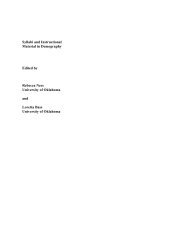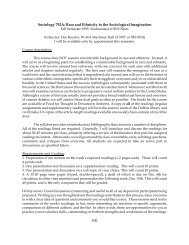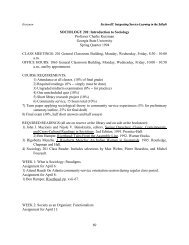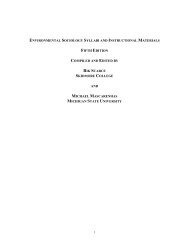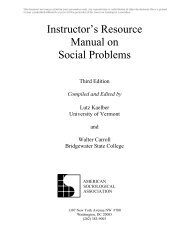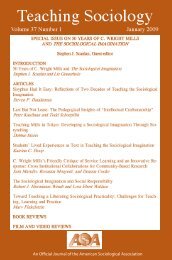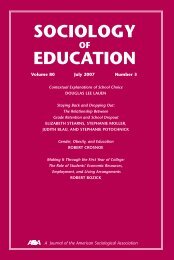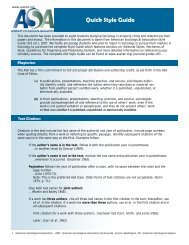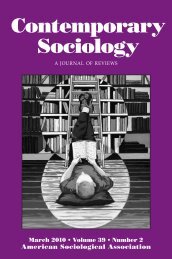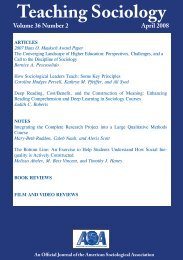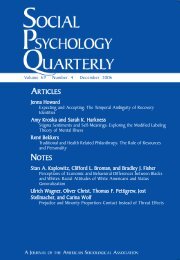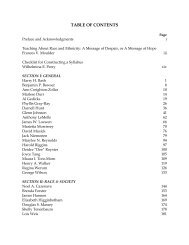SOCIOLOGY EDUCATION - American Sociological Association
SOCIOLOGY EDUCATION - American Sociological Association
SOCIOLOGY EDUCATION - American Sociological Association
Create successful ePaper yourself
Turn your PDF publications into a flip-book with our unique Google optimized e-Paper software.
Another Way Out 371<br />
ures of contact with the juvenile justice system<br />
and dropout. While upholding the structure<br />
of life-course models of crime and<br />
dropout, such lags also increase vulnerability<br />
to selection maturation and selection history<br />
biases, which would inflate the adverse<br />
impact of sanctions (Shadish, Cook, and<br />
Campbell 2002).<br />
Finally, prior studies suffered from a variety<br />
of measurement issues that led to imprecise<br />
parameter estimates. Except for Bernburg and<br />
Krohn (2003), all previous studies measured<br />
only self-reported contact with the juvenile<br />
justice system, which probably led to considerable<br />
false negative and false positive identification<br />
of some arrestees (Kirk 2006). In three<br />
studies, the unclear temporal sequence of<br />
arrest and key selection factors like delinquency<br />
and school failure may have introduced<br />
conservative bias (Bernburg and Krohn 2003;<br />
Hannon 2003; Hjalmarsson 2008). In addition,<br />
for cases in which arrest and dropout<br />
occurred during the same survey wave,<br />
Bernburg and Krohn (2003), Sweeten (2006),<br />
and Hjalmarsson (2008) were unable to determine<br />
which event came first. The precise<br />
effects of sanctions on dropout were not<br />
properly estimated because their analyses<br />
either assumed that dropout always occurs<br />
after arrest or improperly excluded youths<br />
who dropped out shortly after arrest. Last, the<br />
outcome measures in two studies were of<br />
questionable relevance. Hannon (2003)<br />
found that arrests do not predict dropout<br />
among poor youths, perhaps because the<br />
reported models classified GED recipients as<br />
nondropouts. De Li (1999) found that juvenile<br />
convictions diminished status attainment<br />
among working-class London youths, but the<br />
outcome measure combined school completion<br />
and occupational prestige.<br />
AIMS AND STRATEGIES OF THE<br />
STUDY<br />
My study had two central aims. First, it estimated<br />
the predictive influence of officially<br />
recorded juvenile arrests relative to major predictors<br />
of dropout in a context in which<br />
arrests and dropout are of greatest concern.<br />
Drawing a large sample from inner-city<br />
Chicago ensured a sizable court-involved sub-<br />
sample (both sexes) that represented a wide<br />
range of offenders, offenses, and sanctions.<br />
Although the study is not broadly generalizable<br />
like national studies, it is the first that<br />
should roughly generalize to minority-dominated<br />
schools and neighborhoods in other<br />
major cities. Second, the study attempted to<br />
isolate the impact of legal intervention from<br />
the complex of behaviors and circumstances<br />
that trigger it.<br />
I used three strategies to reduce the selection<br />
bias that beset prior research. First,<br />
dropout models controlled for several variables<br />
that potentially confound all previous<br />
estimates of the effects of arrest on dropout.<br />
Such controls included time spent hanging<br />
out, peer delinquency, absences, anger control,<br />
and school and neighborhood conditions.<br />
This strategy permitted me to assess the<br />
predictive value of arrest relative to established<br />
precursors of dropout. Second, I<br />
reduced selection maturation and history<br />
biases by modeling not only the odds of eventually<br />
dropping out of school, but the odds of<br />
dropping out before Grade 11 and before<br />
Grade 10.<br />
Third, to address hidden bias, I conducted<br />
two quasi-experimental analyses. In the<br />
absence of a complete theory of the selection<br />
process, there are real limits to relying exclusively<br />
on measured covariates to reduce all or<br />
most selection bias (Cook et al. 2008).<br />
Unobserved factors (e.g., self-control, gang or<br />
family conflicts, or intelligence) may still<br />
explain why arrested students drop out more<br />
often. Finding that court intervention portends<br />
diminished educational attainment has<br />
weighty policy implications, so it is important<br />
to discern whether arrests precipitate dropout<br />
or merely forecast it.<br />
Improving causal inference requires minimizing<br />
observed and unobserved differences<br />
between sanctioned and nonsanctioned<br />
youths. Since random assignment was impossible,<br />
I conducted two quasi-experimental analyses<br />
that estimated the impact on dropout of<br />
being arrested during the 9th grade (high<br />
school’s modal year of the first juvenile arrest).<br />
The first approach was described by Cook et al.<br />
(2008) as “focal, local, intact group matching.”<br />
It requires sampling groups so as to minimize<br />
initial differences between the intervention<br />
(9th-grade arrestees) and comparison populations.<br />
The comparison group that was selected



